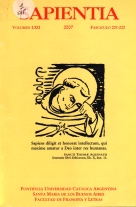Por favor, use este identificador para citar o enlazar este ítem:
https://repositorio.uca.edu.ar/handle/123456789/4489| Título: | El problema del innatismo en Antonio Rosmini : (parte II) | Autor: | Franck, Juan F. | Palabras clave: | Rosmini, Antonio, 1797-1855; INNATISMO; FILOSOFIA; Descartes, René, 1596-1650; Locke, John; Leibniz, Gottfried Wilhelm, 1646-1716; Malebranche, Nicolás, C. Or., 1638-1715; Kant, Immanuel, 1724-1804 | Fecha de publicación: | 2007 | Editorial: | Pontificia Universidad Católica Argentina. Facultad de Filosofía y Letras | Cita: | Franck, J. F. El problema del innatismo en Antonio Rosmini : (parte II) [en línea]. Sapientia. 2007, 62 (221-222). Disponible en: https://repositorio.uca.edu.ar/handle/123456789/4489 | Resumen: | Resumen: Esta parte del artículo repasa las principales teorías modernas sobre el innatismo, analizando sus puntos fuertes y débiles a partir de la teoría rosminiana de la presencia innata de la idea de ser. Se subraya la simplicidad de esta teoría, lo que le confiere un elevado carácter explicativo, en contraste con los dificultades que suscitan las filosofías de Descartes, Locke, Leibniz, Malebranche y Kant. Abstract: This part of the article reviews the main modern theories on innatism, and assesses the strength and the weakness of each of them from the point of view of the Rosminian theory of the innate presence of the idea of being. It highlights the simplicity of such theory, which confers on it a highly explaining value, in contrast with the difficulties raised by theories like those of Descartes, Locke, Leibniz, Malebranche, and Kant. |
URI: | https://repositorio.uca.edu.ar/handle/123456789/4489 | ISSN: | 0036-4703 | Disciplina: | FILOSOFIA | Derechos: | Acceso Abierto | Fuente: | Versión original impresa en Sistema de Bibliotecas UCA: Sapientia Vol. LXII, Nº 221-222, 2007. |
| Aparece en las colecciones: | SAP - 2007 Vol LXII nro. 221-222 |
Ficheros en este ítem:
| Fichero | Descripción | Tamaño | Formato | |
|---|---|---|---|---|
| problema-innatismo-antonio-rosmini-franck.pdf | 260,29 kB | Adobe PDF |  Visualizar/Abrir |
Visualizaciones de página(s)
345
comprobado en 30-abr-2024
Descarga(s)
486
comprobado en 30-abr-2024
Google ScholarTM
Ver en Google Scholar
Este ítem está sujeto a una Licencia Creative Commons

